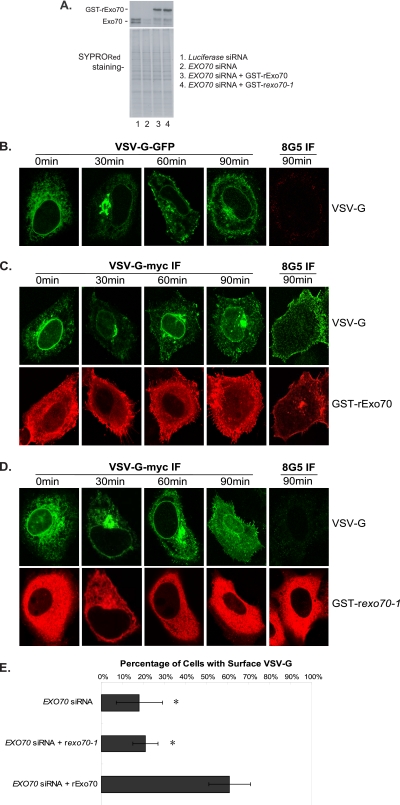Figure 7.
VSV-G ts045 exocytosis defect in EXO70 siRNA knockdown cells expressing the exo70-1 mutant. (A) EXO70 siRNA knockdown cells were transfected with GST-tagged rat Exo70 (GST-rExo70) or rat exo70 mutant (GST-rexo70-1). The amount of endogenous Exo70 in HeLa cells, and the amount of extragenically expressed GST-tagged rat Exo70 were detected by anti-Exo70 monoclonal antibody (top panel). The total proteins in the cell lysates were detected by SYPRORed staining (bottom panel). (B) VSV-G-GFP trafficking in HeLa cells transfected with EXO70 siRNA. The cells were grown at 40°C overnight after transfection. The cells were then shifted to 32°C for 0, 30, 60, and 90 min in the presence of cycloheximide, fixed, and stained as described in Materials and Methods. The 8G5 monoclonal antibody was used to detect the surface-incorporated VSV-G. (C and D) VSV-G-myc trafficking was examined in EXO70 siRNA knockdown cells expressing GST-rExo70 (C) or GST-rexo70-1 (D). VSV-G-myc and GST-tagged wild-type rExo70 (C) or exo70-1 (D) were cotransfected into EXO70 knockdown HeLa cells. VSV-G transport to the PM was rescued in the EXO70 siRNA knockdown cells expressing wild-type rExo70, whereas VSV-G transport was not rescued in the EXO70 siRNA knockdown cells expressing exo70-1. (E) Quantification of the percentage of cells with surface VSV-G staining.

